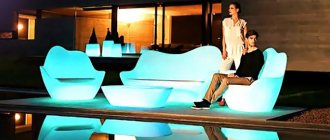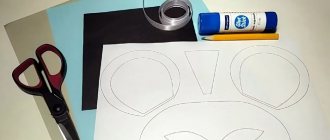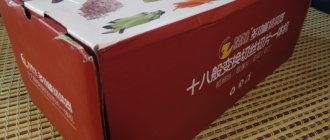04/19/201604/20/2016 master
Today, many lighting fixtures are equipped with diffusers. With their help, the formation of a luminous flux of the required quality is ensured.
Many lamps sold in lighting stores today are already equipped with such elements. But if desired, anyone can try to make such an element with their own hands. This way you will not only spend time with interest and benefit, but you will also be able to equip any home lamps with this kind of addition. And you won't have to run to the store.
Features, application and instructions for making a light diffuser for LED strip
To give the light flux uniformity and directionality, it is necessary to attach a characteristic optical design to the lamp.
For an LED strip, its role is played by a special diffuser. However, as a rule, ice strips are not supplemented with such devices when sold - they need to be made independently or ordered separately, depending on the conditions of use and the parameters of the lighting device based on them. Let's consider what the operating principle of such a device is and what its function is, what types exist and where they are used, as well as how to make them yourself and what materials are required for this.
Glass frosting options
Chemical method
A layer of special paste is applied to one side of the diffuser. It literally “etches” the glass, changing its crystal lattice to a certain depth. The result is a matte surface.
Pros - high speed of work, uniformity and homogeneity of the resulting layer.
Cons – matting pastes are expensive; In addition, you will have to practice on several fragments to get a good result. The difficulty lies in determining the required thickness of the applied paste and the uniformity of its placement. It’s not difficult to do everything correctly with your own hands if you have experience in such work. But a beginner will have to spend a fair amount of time.
Read about how to connect LED strips with connectors here.
Mechanical method
Glass can be processed with any abrasive. To make matting better and more uniform, it is necessary to use materials with fine fractions. For example, sand.
Pros – good speed; It is quite difficult to make a mistake, since the result of processing is immediately visible.
The downside is that regular sandpaper (for sanding) cannot achieve high quality matting on some types of glass. In addition, this work is quite labor-intensive and will require a lot of time. For ordinary silicate glass (window glass), you will need a sandblasting machine. It’s not difficult to make the simplest option with your own hands, but you will have to look for a source of compressed air.
It is unlikely that anyone will purchase a compressor to make a diffuser. But if it is possible to get it, at least for a while, then it is better to work with it rather than with paste.
Plus - no hassle; everything you need is at hand.
The downside is that it will take not only time, but also extreme care and accuracy.
All the technologies discussed above are suitable for cases where there is some kind of box through which the LED strip is laid.
Or if it is mounted inside a piece of furniture, which requires additional glazing. But such methods of making a diffuser are hardly suitable for motorists. There is a more advanced technique that is applicable to any type of LED devices, regardless of their power, geometry and installation location.
Function and principle of operation of the diffuser
The peculiarity of the LED strip is that the luminous flux from it extends to an angle of no more than 120 degrees. This significantly impairs their practical usefulness. To correct the situation, it is necessary to place a material that refracts and scatters light in close proximity to the lamps.
This is exactly the function that the LED diffuser performs. Its internal structure is based on a disordered arrangement of particles of matter. As a result, light, when passing through such a material, deviates significantly from its original trajectory - and in different directions. As a result, the light flux simultaneously weakens somewhat and expands evenly.
Note! You can see and understand the operating principle of a diffuser for an LED lamp using the following example. You need to put a small piece of matte cellophane on top of the led tape. The luminous flux from such a scattering film will immediately become slightly muted and evenly distributed over the entire illuminated area.
The diffuser or diffuser used for LED strips consists of two main elements - a housing and a light-transmitting plate. In modern models, the first part of the device is presented in the form of a plastic, aluminum or stainless steel profile of the following shapes:
Its geometry is determined primarily by the place where the diffuser is used, the types of brackets for it, features and operating conditions. An LED strip is glued to the base of the profile, and then the top is covered with transparent or matte material. The former are used when strong illumination of any selected areas is required - for example, display windows in a store, the latter - when it is necessary to create general unobtrusive lighting, for example, in a restaurant.
There is also a flexible profile for LEDs. Essentially it is a silicone tube with the ability to place an LED strip inside it. Due to their high plasticity, they can be given any shape, which is important when designing complex figured decor, advertising signs, and trees.
Design
The LED strip is a flexible printed circuit board. It has evenly spaced diodes and current-limiting resistors. The width of the device varies between 8 and 20 mm. The power of the light flux is determined by the size of the diodes mounted on the board.
Other characteristics of LED devices include the following:
- Chroma. Monochrome (white and color) as well as multi-color (RGB) models are available. Multicolor devices are capable of creating any shade by mixing the colors of the three available light diodes.
- Supply voltage. The device operates on 12 Volts or 24.
- LED type. There are low-power modifications (SMD3528) and high-power devices (5050, 5630). The numbers indicate the sizes of the diodes. For example, in model 3528 they are 3.5x2.8 mm.
Materials for making the diffuser
A modern range of ready-made optical materials allows anyone to make their own diffuser for an LED strip. Among the most suitable options are:
Let's consider their main characteristics and application features.
Acrylic and plexiglass
Types of plastic such as acrylic and plexiglass are characterized by the same light-scattering abilities as traditional glass (they transmit about 90% of radiation). At the same time, they are characterized by maximum anti-vandal characteristics and do not crack from constant changes in climatic conditions, sudden changes in temperature from plus to minus sixty and mechanical influences.
Interesting! Among the disadvantages are flammability in direct contact with fire and low resistance under high impact loads.
Polystyrene
One of the thermoplastic polymers is characterized by high light transmittance, greater than that of standard glass (about 98%). Polystyrene is versatile and easy to process, resistant to thermal changes and localized strong impacts.
Its main advantages are low cost and significant color variety - from completely transparent to rich, bright shades. However, in general, a plate of such material is quite fragile and can ignite when exposed to open fire.
Polycarbonate
The characteristic properties of polycarbonate are strength, light weight and good light transmittance. In practice, a diffuser for LED strips made of such material is not afraid of contact with open fire, strong winds, heavy rain, hail and attacks from vandals. Moreover, in structure it differs into two subtypes:
DaShiftman › Blog › Do-it-yourself portable LED spotlight for the garage (part 1)
Hello everyone! Recently, my father asked me to make him a portable spotlight for the garage, because... often works with metal, power tools, etc. I wanted to make it both bright and economical, but what is the conclusion? That's right LEDs.











